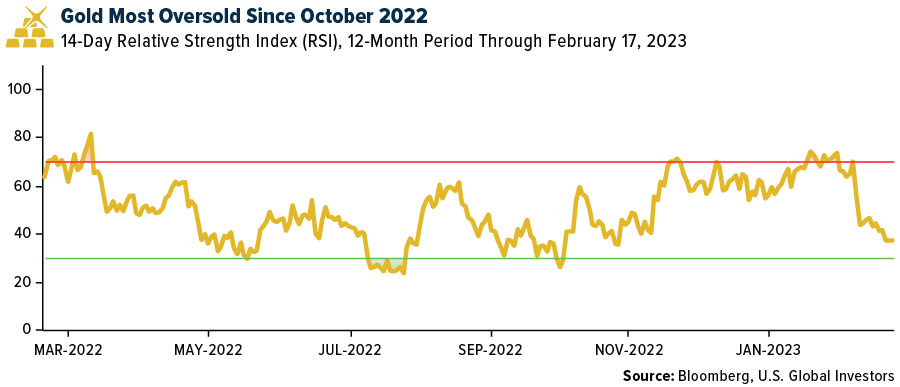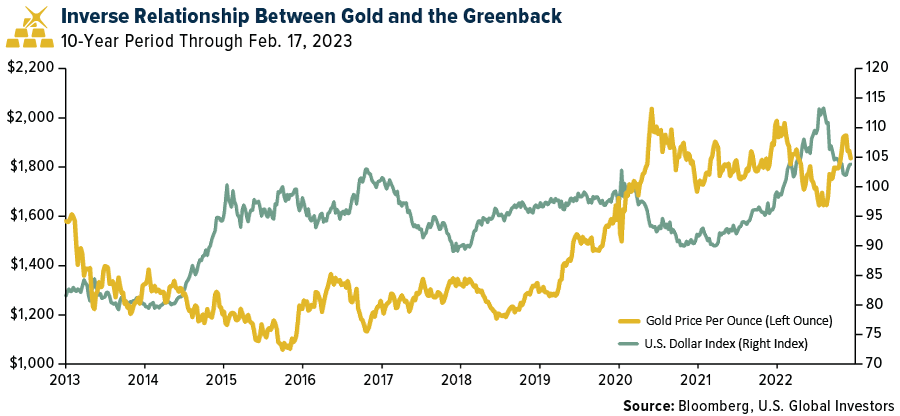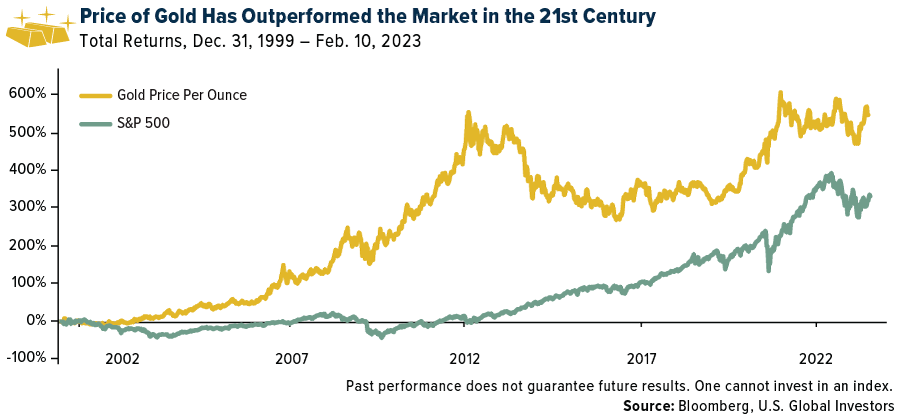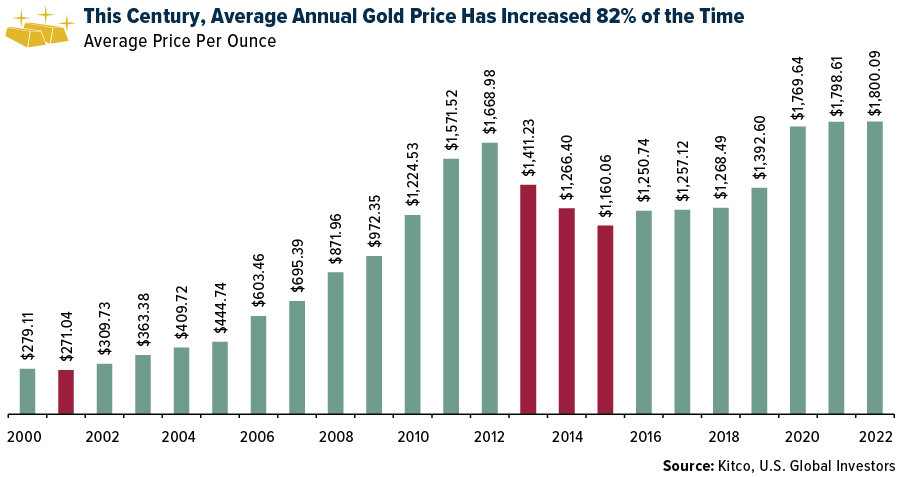According to some analysts, gold appears to be nearing its strongest “buy” signal in four months as the U.S. dollar eases off a rally that’s carried the greenback to its highest point since early January. According to the 14-day relative strength index (RSI), gold was at its most oversold level since October 2022 at the end of last week, indicating it may be time to consider buying in anticipation of mean reversion. Mean reversion is a financial term for the assumption that an asset’s price will tend to converge to the average price over time.

As we have written in the past, gold and the dollar share an inverse relationship, since the precious metal is priced internationally in the greenback. When the dollar is strong, it may be time to consider accumulating gold. Conversely, when the dollar begins to cool, it may be time to take some profits.

The Economics of Underwear
Gold is currently about 6% off its 2023 high of just under $1,960 an ounce, under pressure from the dollar, which has made gains against a basket of world currencies on economic data that all but guarantees additional rate hikes. Unemployment sits at 3.4%, the lowest reading in more than half a century, giving the Federal Reserve the go-ahead to continue its fight against inflation.
Last week’s consumer price index (CPI) report showed that inflation is still running hotter than expected. Consumer prices rose 0.5% between December and January, up from an increase of 0.1% in the November-to-December period. Some of the items and services that jumped the most in price in January were utility gas services, eggs, breakfast sausage and ham, instant coffee and—just in time for tax season—tax return preparation services.
The price of men’s underwear rose 5.5% month-over-month, which is notable since this was former Fed Chair Alan Greenspan’s favorite economic indicator. According to Greenspan, a jump in underwear demand could mean that the economy is on solid footing, the reason being that no one’s aware if you’re wearing a pair of old skivvies or the latest brand-name undergarments. That underwear prices jumped so much from December to January implies that consumers are confident enough in the economy to splurge on something that’s generally out of public view.
Gold Still Beating the Market Over the Long Term
Gold’s technicals may be telling us it’s time to consider buying, and its long-term fundamentals remain healthy and attractive. In the chart below, we have updated the performance comparison between gold and the S&P 500 since the start of the century. The metal is still beating the market as of February 10, by a factor of approximately 1.6.

In 2022, gold’s price was mostly supported by strong bullion demand in the U.S. and Western Europe and record purchases by central banks. We may see a repeat of the big buying this year, if one forecast turns out to be right.
Goldman Sachs analysts believe that global central banks are on track to add an unprecedented amount of gold by the end of 2023 as they seek to diversify away from the U.S. dollar. That’s especially the case following U.S.-led sanctions against Russia for its invasion of Ukraine.
Central banks purchased a record 1,136 tons of gold in 2022, the equivalent of 40 million ounces, according to the World Gold Council (WGC). Turkey was the biggest official buyer at roughly 147 tons, followed by China at 62 tons and Egypt at more than 44 tons.
But banks could top that amount this year, with imports potentially exceeding 1,200 tons, Goldman says. Combined with improving economic conditions in China and India, the world’s two largest consumers of gold, the precious metal’s price could average $1,950 an ounce in 2023.
Although not a record total amount, $1,950 would represent a record average amount, as you can see below.

In 19 of the past 23 years, or around 82% of the time, the average price of gold has risen year-over-year. If the metal were to average $1,950 this year, it would mark the eighth consecutive year of average-price increases.
For more on investing in gold – specifically gold miners or gold royalty names – we invite you to explore the U.S. Global GO GOLD and Precious Metal Miners ETF. Click here to learn about GOAU!
All opinions expressed and data provided are subject to change without notice. Some of these opinions may not be appropriate to every investor.
Please carefully consider a fund’s investment objectives, risks, charges, and expenses. For this and other important information, obtain a statutory and summary prospectus for GOAU here. Read it carefully before investing.
Investing involves risk, including the possible loss of principal. Shares of any ETF are bought and sold at market price (not NAV), may trade at a discount or premium to NAV and are not individually redeemed from the funds. Brokerage commissions will reduce returns. Because the funds concentrate their investments in specific industries, the funds may be subject to greater risks and fluctuations than a portfolio representing a broader range of industries. The funds are non-diversified, meaning they may concentrate more of their assets in a smaller number of issuers than diversified funds.
The funds invest in foreign securities which involve greater volatility and political, economic and currency risks and differences in accounting methods. These risks are greater for investments in emerging markets. The funds may invest in the securities of smaller-capitalization companies, which may be more volatile than funds that invest in larger, more established companies. The performance of the funds may diverge from that of the index. Because the funds may employ a representative sampling strategy and may also invest in securities that are not included in the index, the funds may experience tracking error to a greater extent than funds that seek to replicate an index. The funds are not actively managed and may be affected by a general decline in market segments related to the index.
Gold, precious metals, and precious minerals funds may be susceptible to adverse economic, political, or regulatory developments due to concentrating in a single theme. The prices of gold, precious metals, and precious minerals are subject to substantial price fluctuations over short periods of time and may be affected by unpredicted international monetary and political policies. We suggest investing no more than 5% to 10% of your portfolio in these sectors.
Fund holdings and allocations are subject to change at any time. Click here to view fund holdings for GOAU.
Distributed by Quasar Distributors, LLC. U.S. Global Investors is the investment adviser to GOAU.
The Relative Strength Index (RSI) is a momentum indicator that measures the magnitude of recent price changes to analyze overbought or oversold conditions. Mean reversion is a financial theory positing that asset prices and historical returns eventually revert to their long-term mean or average level.
The U.S. Dollar Index (USDX) indicates the general international value of the USD. The USDX does this by averaging the exchange rates between the USD and major world currencies.
The S&P 500 Stock Index is a widely recognized capitalization-weighted index of 500 common stock prices in U.S. companies.
It is not possible to invest in an index.
